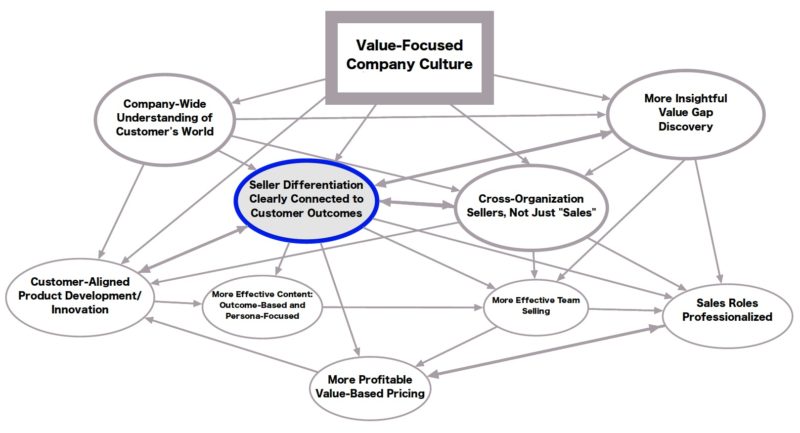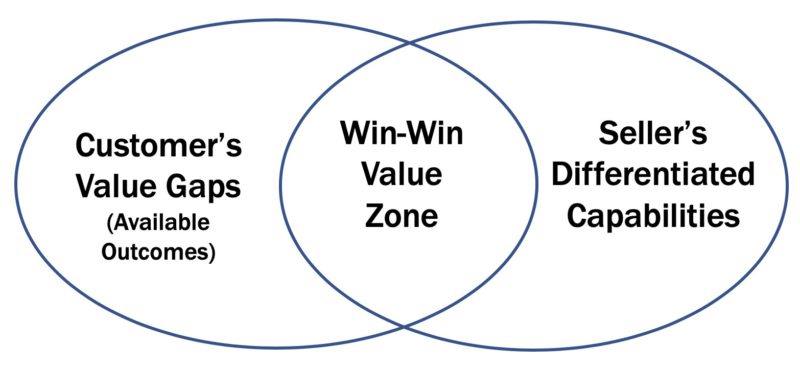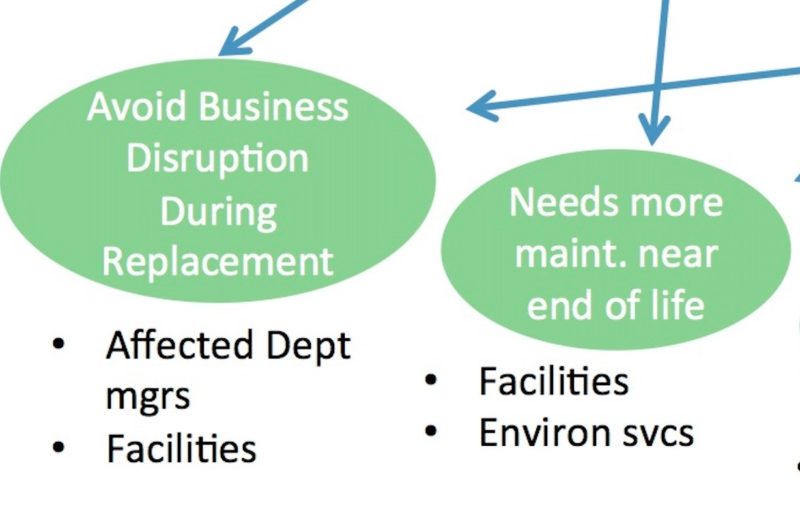
By Mark Boundy
Using Value Networks to Grow Your Business
Using Value Networks to Grow Your Business https://csuiteold.c-suitenetwork.com/advisors/wp-content/themes/csadvisore/images/empty/thumbnail.jpg 150 150 Mark Boundy https://secure.gravatar.com/avatar/fda1708afcd4681826f4fb12f56401d9?s=96&d=mm&r=g
The craft of sales is one of increasing the overlap between what outcomes a customer desires for themselves, and what outcomes the seller’s offer can deliver.

Increasing that overlap requires the seller to:
- Conduct insightful discovery into the customer’s business and personal situation to increase the range of desired outcomes.
- Identifying an exhaustive list of seller’s capabilities, then translating those into customer business outcomes.
- Articulate unmet value gaps to product/service innovators, who develop high-impact differentiation.
Most commercially available sales training addresses the first item. Almost all leave the second item up to an internal product training function. By “leaving it to the product trainer”, I mean ignore completely. No good framework to fill this gap has been introduced.
Introducing the Value Network.
The Value Network is a great tool. It:
- Captures deal-winning gold from top sellers for use by the whole team
- Helps everyone in B2B sales teams sell more widely and deeply
- Ramps new sellers up more rapidly
- Guides more impactful executive conversations
- Shapes more impactful marketing
- Informs superior new product idea generation
- Helps non-sales, but still customer-facing roles uncover new value.
- Serves as a central point of truth for competitive positioning.
- It is easy to learn and intuitive to use.
…so why don’t you know what a Value Network is?
A value network diagrams all of the possible customer outcomes your differentiation can drive for a customer. The diagram at the top of this article is a partial value network: it illustrates the client outcomes from adopting the kind of value-focused culture I propose in my upcoming book, Radical Value.
Building A Value Network
Start by describing an area of differentiation. In the example above, I promote building a company culture focused on value to the customer (yes this is different from many organizations, surprisingly. Companies focus their cultures on lots of other things when value is what they should use as the hub around which everything else rotates).
From that differentiation (drawn above in a rectangle), describe all of the customer outcomes that result…and the outcomes those outcomes deliver, and so on. Draw those customer outcomes in ovals with arrows representing cause/effect (you’ll notice a few bidirectional arrows on this diagram, which shows mutual reinforcement loops) The resulting network represents all of the potential value your differentiation could deliver to a customer.
In the current vernacular, these might be called themes for value messages. That is, they could be likely hypotheses that one could deliver to a prospect (or use as a justification for a meeting) – but then validate through dialogue.
For this article, I’ve outlined in blue where the use of a value network fits in a value-focused culture. It enables or drives more insightful business discussions: by not just salespeople, but every person who comes in contact with your customer. It clarifies innovation in business cases. It
Next Step: Make Each Outcome Personal.
To keep the diagram above clean, I didn’t perform this step, but here’s what to do next. Next to each oval, list the customer personas most likely to desire that outcome. Here’s an example in closeup from a different value network:
Notice that Facilities is likely to find value in both of these outcomes, but affected department managers are only likely to care about one of the two. This targeting analysis guides meeting plans, sales conversations, account-based marketing content, product innovation, and more. It also helps guide executive selling efforts by identifying executive-worthy conversations.
Making the Complex Simple
Building customer-perceived value is the selling behavior that most affects customer buying decisions. Value is defined as the desirability of customer outcomes and is built off of differentiation. A Value Network is a tool that articulates all of the possible business outcomes your offer could produce for a customer.
Depending on what it is your company sells (product, service or solution), being able to efficiently identify all customer impacts is where the great sales conversation training (the one you’ve probably already invested in) begins. In my work with hundreds of B2B companies, I can confidently tell you that there is room for improvement in refining your “product” (which includes service) training. Value Networks can help everyone involved craft a simple set of training, content, and other materials guaranteed to improve the quality of your customer conversations, supporting higher win rates at more mutually-beneficial prices.
Here’s An Exercise For You to Apply This Article
The diagram at the top of this article was purposely left incomplete. Extend it using the bullet point statements under the section titled “Introducing the Value Network” plus any others you can think of. Now, study the bigger Value Network and consider what each of these outcomes means to you in your role: both professionally and personally. What would developing a company-wide focus on customer value do for you and your organization?
Comment below, or contact me if you’d like to learn more about this simple, powerful tool. Or get on the waiting list for my upcoming book, where I’ll go into even more detail on how-to and use of Value Networks.
To Your Success!


